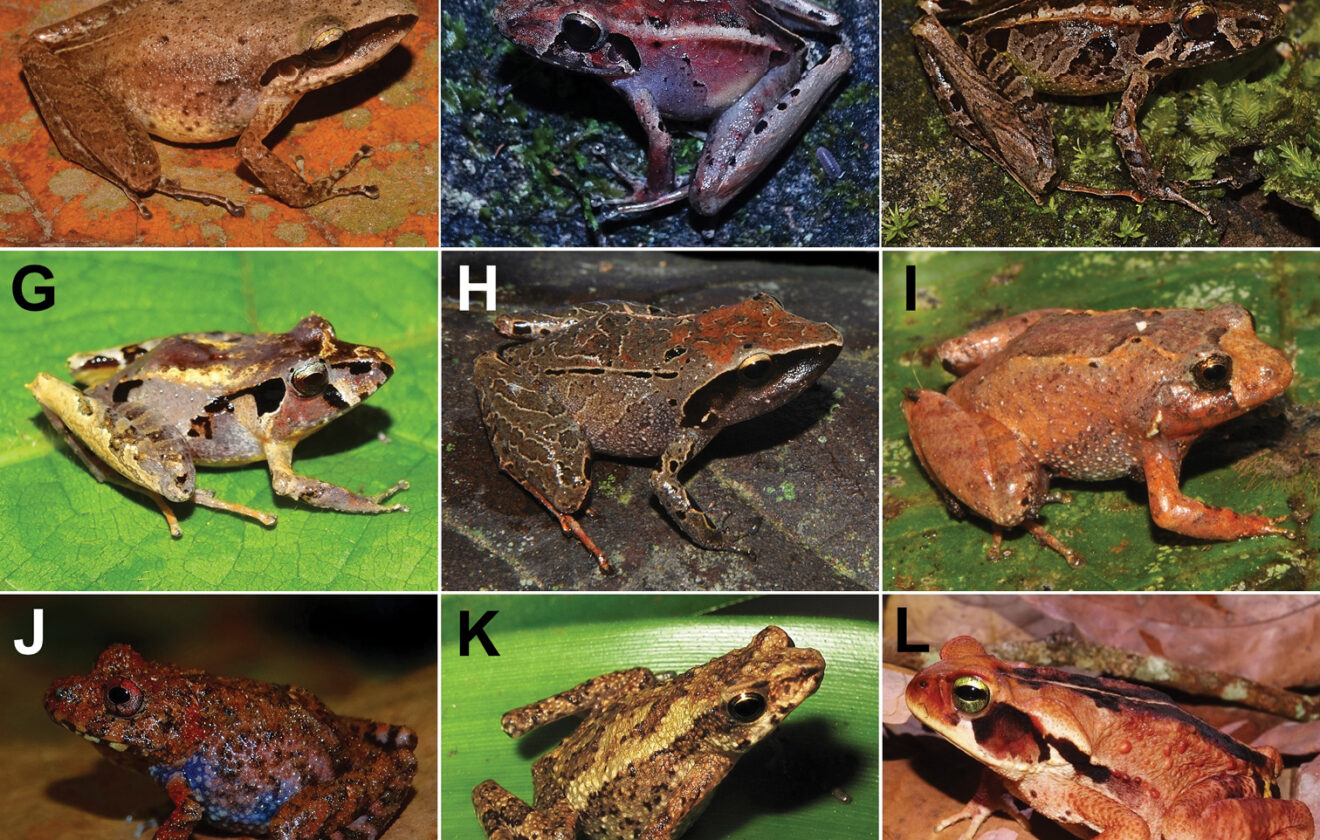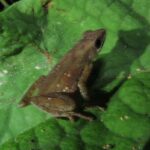Ischnocnema nasuta: The Elusive Frog of Brazil’s Atlantic Rainforest#
Tucked deep within the verdant layers of Brazil’s lush Atlantic Rainforest, there exists a diminutive denizen whose quiet presence weaves seamlessly into the tapestry of humid understory and dense foliage. Its soft calls blend into the rainforest serenade; its appearance, subtle and unassuming, masks an extraordinary evolutionary journey. This fascinating frog, known scientifically as Ischnocnema nasuta, often goes unnoticed amidst the grandeur of jaguars and harpy eagles, yet plays a pivotal role in this biologically rich ecosystem. Belonging to the family Brachycephalidae, Ischnocnema nasuta epitomizes the astonishing complexity and vulnerability of tropical amphibians.
Remarkably, this species lacks the aquatic tadpole stage commonly associated with frogs, a trait that speaks volumes about its adaptation to terrestrial life. Beyond its subtle brown hues and discreet habits lies a hidden world full of intriguing details, from unique reproductive strategies to essential ecological contributions, making Ischnocnema nasuta an exemplar of evolutionary innovation and environmental reliance.
Taxonomy and Classification#
Ischnocnema nasuta, commonly referred to as the nosed robber frog, belongs to the family Brachycephalidae, under the genus Ischnocnema. This group encompasses numerous terrestrial frogs found predominantly in South America that showcase remarkable terrestrial reproductive adaptations and diverse morphology.
First officially described in scientific literature by researchers Lutz in 1925, its classification underwent revisions with advancing molecular studies, solidifying its placement within Brachycephalidae. Its genus, Ischnocnema, is renowned for species that mainly lay terrestrial eggs, bypassing aquatic larval stages. Close relatives share similar morphological features and terrestrial reproduction, emphasizing the importance of rainforest floor microhabitats. Understanding its precise taxonomy not only honors its scientific legacy but strengthens conservation efforts by clearly delineating its unique ecological niche among Brazilian amphibians.
Natural Habitat#
Ischnocnema nasuta’s existence is intricately tied to Brazil’s Atlantic Rainforest, a biodiversity hotspot renowned for its staggering number of species and threats posed by habitat fragmentation and deforestation. Its range encompasses primarily southeastern Brazil, from the coastal lowlands to the foothills and mid-altitude forests of the mountain ranges in states such as São Paulo, Rio de Janeiro, Minas Gerais, and Espírito Santo. Here, dense, humid forests provide a particularly favorable microclimate—and it is within this verdant labyrinth of moss-covered stones, leaf litter, and fallen logs that Ischnocnema nasuta thrives.
Unlike frogs reliant on aquatic environments for breeding, this species favors terrestrial environments—secluded and moisture-rich microhabitats where humidity and temperature remain relatively stable. Lacking an aquatic larval stage, it depends heavily on forest integrity for egg-laying and survival. Its preference for the moist, shaded forest floor allows it camouflage and protection from predators and environmental extremes, while also offering ample prey in the form of insects and other small invertebrates. Each fallen leaf or decomposing log invites a micro-ecosystem supportive enough to shelter its entire life cycle.
Physical Characteristics#
Though the Ischnocnema nasuta is small, averaging only about 20 to 30 millimeters in length, its elegantly adapted form speaks volumes of evolutionary refinement. Like a leaf fragment brought to life, its cryptic coloration and texture—from muted browns and soft earth tones to subtle patterns—serve as exceptional camouflage against leaf litter and earthy debris. The skin holds subtle markings, darker lines, and mottlings that further enhance its concealment, allowing the frog to effortlessly blend with surrounding vegetation. Its most distinguishing feature, giving rise to its name (“nasuta,” meaning “nosed”), is a slightly elongated snout, enhancing its reptile-like visage.
Short limbs and modest digits, unaccompanied by significant toe pads, reflect its adaptation to ground-dwelling rather than arboreal life. Its leathery texture helps regulate moisture retention and offers protection from parasites, thorny vegetation, and minor injuries. Indeed, the physical adaptations of Ischnocnema nasuta perfectly reflect the interplay between evolutionary pressures and the unique demands of its specialized forest-floor habitat.
Behavior and Life Cycle#
The life of Ischnocnema nasuta transpires largely hidden from view, manifesting most notably during the twilight hours. A nocturnal predator and opportunistic feeder, it subsists mainly on ants, termites, spiders, and small insects. Its method of hunting is patient and stealthy, utilizing camouflage to ambush prey unwittingly venturing close enough into its strike zone. Only subtle movements of its cautious limbs might betray its presence—otherwise, it remains motionless, relying heavily on surprise and precision to secure meals.
An Intriguing Reproductive Strategy#
The reproductive biology of Ischnocnema nasuta displays fascinating adaptations that defy expectations. Unlike frogs that lay eggs in bodies of water and develop tadpoles in aquatic nurseries, Ischnocnema nasuta deposits its eggs in moist terrestrial environments. Females typically choose concealed niches in leaf litter or beneath moss-coated logs, safe from immediate predation and desiccation. Remarkably, these terrestrial eggs bypass a free-swimming tadpole stage entirely, instead developing directly into miniature froglets—a strategy known scientifically as direct development.
Male frogs produce subtle calls to attract mates, creating gentle choruses that mingle harmoniously with the rainforest’s rich acoustic landscape. Though softer in intensity compared to many other frog species, these calls effectively convey reproductive status to potential mates, ensuring continuation of their lineage. This lack of dependency on water makes the species more closely tied to terrestrial moisture and forest integrity—necessitating the preservation of their rainforest habitat.
Ecological Role#
Despite its unobtrusive presence, Ischnocnema nasuta plays an essential ecological role as both predator and prey. By feeding on insects and small invertebrates, it provides indispensable control of arthropod populations, sustaining ecological balance. Its dietary habits indirectly aid in seed dispersal and nutrient recycling, contributing to overall ecosystem health.
Conversely, this frog provides crucial nourishment to predators such as birds, snakes, and small mammals, placing it firmly within the food web. Moreover, amphibians like Ischnocnema nasuta are frequently regarded as key indicator species; their presence or absence can reflect the overall ecological health of their habitat, particularly in assessing the quality of terrestrial microhabitats in tropical rainforests.
Threats and Conservation Status#
Unfortunately, the ensemble of subtleties that make Ischnocnema nasuta so perfectly adapted also exposes it to considerable risk in an ever-changing world. Habitat destruction, particularly from expanding agriculture, logging, urbanization, and infrastructure development, poses the greatest threat. Brazil’s Atlantic Rainforest, home to this and many other diverse organisms, has been dramatically reduced in area and connectivity, isolating frog populations and making them highly susceptible to localized extinction.
Moreover, climate change, pollution, and diseases such as chytridiomycosis present serious challenges for survival, potentially exacerbating pressures on their already fragile environment. Presently listed by the International Union for Conservation of Nature (IUCN) as Least Concern, this classification should not encourage complacency—instead, conservation efforts should actively protect and restore habitats sustaining this remarkable species. Promoting protected areas, habitat corridors, and community-based conservation programs represents vital strategies to safeguard its future.
Cultural and Scientific Significance#
While Ischnocnema nasuta might not prominently feature in cultural folklore, frogs generally symbolize renewal, transformation, and environmental health in various cultures and traditions. Scientifically, the species contributes enormously to the understanding of evolution, particularly terrestrial reproductive strategies and adaptive physiology. Studies on direct development help inform evolutionary biology, ecology, and the broader conservation perspective considering amphibians’ fragility in changing environments.
Conclusion#
In embracing the story of Ischnocnema nasuta, we discover that even the most modest of creatures carries profound ecological and evolutionary significance. This diminutive forest-floor dweller symbolizes the delicate interconnectedness of life, underscoring the urgent need for conservation efforts to safeguard biodiversity-rich ecosystems, like Brazil’s Atlantic Rainforest.
Protecting the subtle voice hidden in the leaf-litter, the purposefully camouflaged forms merging seamlessly into shadows, tells a deeper narrative—one reminding us that every species, no matter how small or discrete, deserves appreciation, respect, and, above all, protection.








